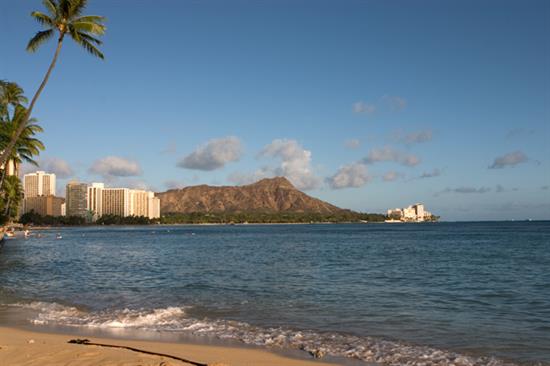 |
Hawai'i was also known as the Sandwich Islands when this map was
published in 1893 |
Described by Mark Twain as "the loveliest fleet of islands that lies anchored in any ocean," the State of Hawai‘i encompasses a string of some 140 islands and atolls and their adjacent oceans stretched over 1,500 miles in the north central Pacific Ocean from Hawai‘i Island in the southeast to Kure Atoll in the northwest. At 2,400 miles from the nearest land mass, the west coast of the continental United States, Hawai‘i is among the most remote and unique locations on earth. In the middle of the Pacific, closer to Asia than it is to Washington, D.C., Hawai‘i is central to the vast Indo-Pacific and has long been a bridge between East and West.
Hawai‘i proudly became our nation’s fiftieth state on August 21, 1959. However, the Aloha State’s story began long before 1959, with the arrival from the south by voyaging canoes more than 1,000 years ago of the Polynesian ancestors of Hawaii’s indigenous peoples, the Native Hawaiians. The era of Western contact began with the arrival of Captain James Cook in 1778 and proceeded through the rapid changes of the Kingdom, Republic and Territory of Hawai‘i to Statehood and the decades since.
Hawai‘i has eight main island: Ni‘ihau, Kaua‘i, O‘ahu, Moloka‘i, Maui, Lana‘i, Kaho‘olawe and Hawai‘i Island. The population is currently about 1.4 million, with 900,000 people, or about 64%, on O‘ahu, where Honolulu, Waikīkī and Pearl Harbor are located.
Hawai‘i has two congressional districts of about 700,000 residents each. The 1st District encompasses urban Honolulu and its immediate suburbs, while the 2nd District includes the rest of O‘ahu and all other islands.
 |
| Diamond Head, Honolulu, Hawai'i |
The 1st District is a compact mostly urban-suburban district located in a relatively narrow strip along the Pacific Ocean measuring some 30 long and at the most some ten miles wide. It stretches from Makapu’u Point in the east, through East and Central Honolulu, to Pearl City and up to Mililani in the north, and down through Waipahu to ‘Ewa and Kapolei in the west. Despite the artificial boundary lines of a congressional district, it is closely connected to the rest of O‘ahu and the other islands of Hawai‘i such that many if not most of its issues are statewide.
The 1st District, like the rest of Hawai‘i, is among the most ethnically diverse of any of our nation’s 440 congressional district, with the highest or (after the 2nd District) second highest Asian American, Native Hawaiian and Pacific Islander populations of any congressional district. It hosts a rich multiethnic culture to go with world-class natural resources and many other unique attributes. You can review further information on the 1st District’s demographics here (Census Bureau’s data for the 1st Congressional District).
As true for Hawai‘i overall, the 1st District’s economy centers around tourism, defense, agriculture and the service industry. Small businesses are key to the local economy. According to the Small Business Administration, 99% of businesses in Hawai‘i are small businesses, and a majority of employees in Hawai‘i are employed by small businesses.
The 1st District is the epicenter of our nation’s Indo-Pacific national defense efforts. It includes many major military facilities, including Joint Base Pearl Harbor-Hickam, Fort Shafter, Camp H.M. Smith, Tripler Medical Center Army Base, Fort DeRussy and Pearl Harbor Naval Shipyard. It also the home of our largest unified command stretching from the West Coast to the west coast of India and from Alaska and the Arctic to Antarctica, U.S. Indo-Pacific Command (USINDOPACOM), together with the regions combatant commands, U.S. Pacific Fleet (PACFLT), U.S. Marine Forces Pacific (MARFORPAC), U.S. Army Pacific (USARPAC), U.S. Pacific Air Forces (PACAF) and United States Space Forces Indo-Pacific and Special Operations Command Pacific (SOCPAC).
As the 21st Century dawned it was recognized as the Pacific Century and in its first generation has proven to be just that Hawaii’s long-standing role as the effective capital of the Pacific with a truly multicultural society leading the way forward for our country and world will only continue to increase.
1st District of Hawai'i - Interactive Map


